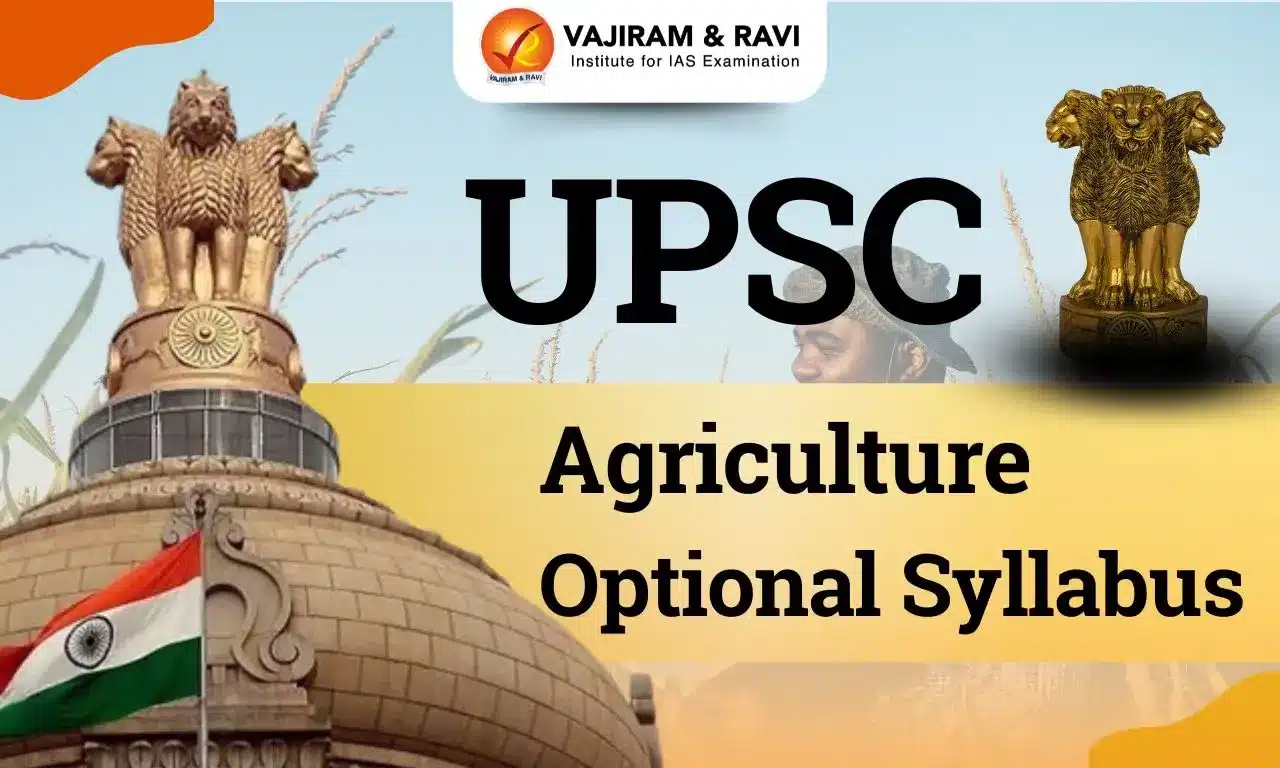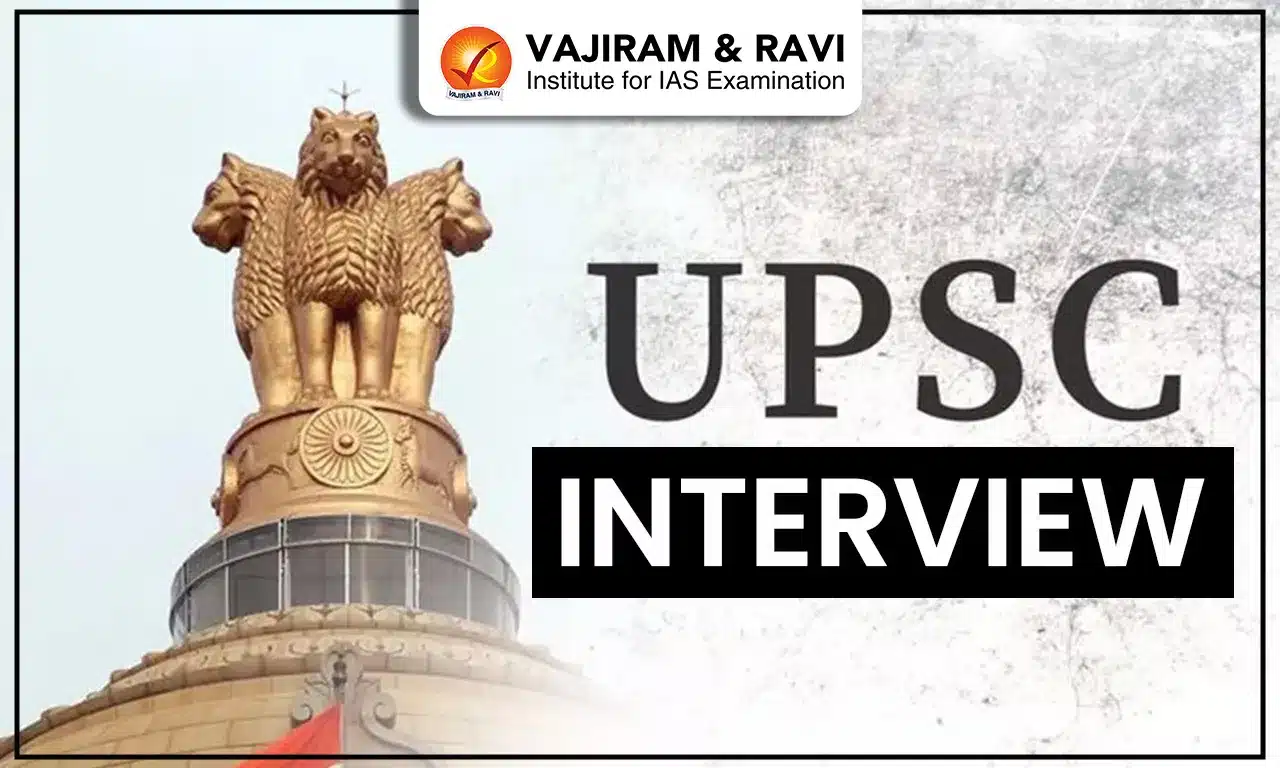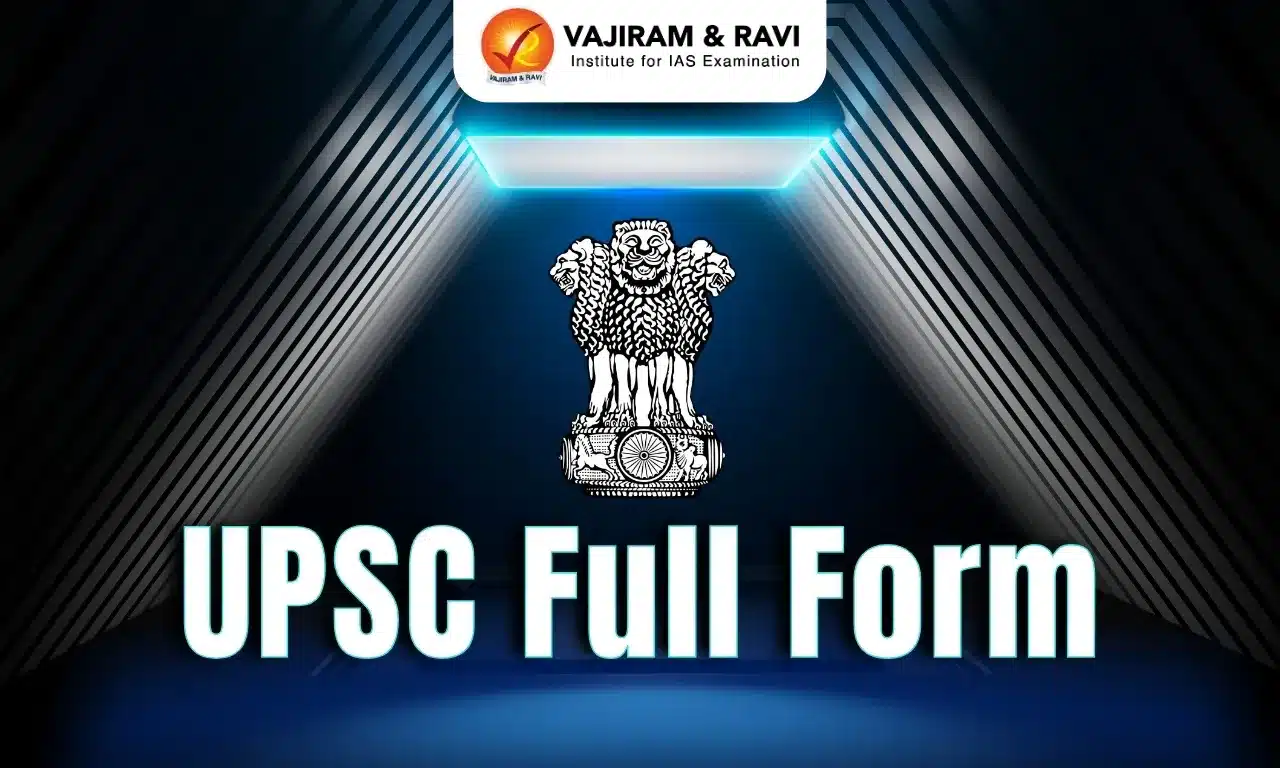The UPSC agriculture optional syllabus contains topics such as forestry, agronomy, agricultural economics, plant genetics, etc. Agriculture is regarded as a technical subject and is ideal for those with an interest in farming and other agricultural pursuits. Additionally, most of the questions asked from the UPSC Agricultural optional syllabus are direct and predictable, guaranteeing a good result.
What is the UPSC Agriculture Optional Syllabus?
The UPSC Agriculture optional syllabus consists of two papers, Paper I and Paper II, each covering specific topics related to agriculture and its allied fields. The Agriculture Optional consists of two papers (Paper-I and Paper-II), each carrying 250 marks, totalling 500 marks.
UPSC Agriculture Optional Syllabus 2026 for Paper 1
| Macro topic | Micro Topics |
| Ecology |
- Ecology and its relevance to man, natural resources, their sustainable management and conservation. - Physical and social environment as factors of crop distribution and production. - Agroecology, cropping patterns as indicators of environments. Environmental pollution and associated hazards to crops, animals and humans. - Climate change – international conventions and global initiatives. Greenhouse effect and global warming. - Advanced tools for ecosystem analysis – Remote sensing (RS) and Geographic Information Systems (GIS). |
| Agronomy |
- Cropping patterns in different agro-climatic zones of the country. - Impact of high-yielding and short-duration varieties on shifts in cropping patterns. - Concepts of various cropping and farming systems. - Organic and Precision farming. - Package of practices for production of important cereals, pulses, oilseeds, fibres, sugar, commercial and fodder crops. |
| Forestry |
- Important features and scope of various types of forestry plantations, such as social forestry, agroforestry, and natural forests. - Propagation of forest plants. Forest products. - Agroforestry and value addition. - Conservation of forest flora and fauna. |
| Weed Science | Weeds, their characteristics, dissemination and association with various crops; their multiplications; cultural, biological, and chemical control of weeds. |
| Soil science and nutrient management |
- Soil- physical, chemical and biological properties. - Processes and factors of soil formation. - Soils of India, Mineral and organic constituents of soils and their role in maintaining soil productivity. - Essential plant nutrients and other beneficial elements in soils and plants. - Principles of soil fertility, soil testing and fertiliser recommendations, integrated nutrient management. - Biofertilizers. - Losses of nitrogen in the soil, nitrogen-use efficiency in submerged rice soils, and nitrogen fixation in soils. - Efficient phosphorus and potassium use. - Problem soils and their reclamation. - Soil factors affecting greenhouse gas emission. |
| Soil and water conservation |
- Soil conservation, integrated watershed management. - Soil erosion and its management. - Dryland agriculture and its problems. - Technology for stabilising agriculture production in rainfed areas. - Water-use efficiency in relation to crop production, criteria for scheduling irrigations, ways and means of reducing runoff losses of irrigation water. - Rainwater harvesting. - Drip and sprinkler irrigation. - Drainage of waterlogged soils, quality of irrigation water, the effect of industrial effluents on soil and water pollution. - Irrigation projects in India. |
| Agricultural economics |
- Farm management, scope, importance and characteristics, farm planning. - Optimum resource use and budgeting. - Economics of different types of farming systems. - Marketing management – strategies for development and market intelligence. - Price fluctuations and their cost; role of cooperatives in agricultural economy; types and systems of farming and factors affecting them. - Agricultural price policy. - Crop Insurance. |
| Agricultural extension |
- Agricultural extension, its importance and role, methods of evaluation of extension programmes, socio-economic survey and status of big, small and marginal farmers and landless agricultural labourers. - Training programmes for extension workers. - Role of Krishi Vigyan Kendra’s (KVK) in the dissemination of Agricultural technologies. - Non-Government Organizations (NGO) and self-help group approach for rural development. |
Agriculture Optional Syllabus - Paper 2
| Macro topic | Micro topics |
| Cell biology/ Plant Genetics |
- Cell structure, function and cell cycle. - Synthesis, structure and function of genetic material. - Laws of heredity. - Chromosome structure, chromosomal aberrations, linkage and cross-over, and their significance in recombination breeding. - Polyploidy, euploids and aneuploids. - Mutations – and their role in crop improvement. - Heritability, sterility and incompatibility, classification and their application in crop improvement. - Cytoplasmic inheritance, sex-linked, sex-influenced and sex-limited characters. |
| Plant breeding |
- History of plant breeding. Modes of reproduction, selfing and crossing techniques. - Origin, evolution and domestication of crop plants, centre of origin, law of homologous series, crop genetic resources conservation and utilization. - Application of principles of plant breeding, and improvement of crop plants. - Molecular markers and their application in plant improvement. - Pure-line selection, pedigree, mass and recurrent selections, combining ability, and its significance in plant breeding. - Heterosis and its exploitation. - Somatic hybridization. - Breeding for disease and pest resistance. - Role of interspecific and intergeneric hybridization. - Role of genetic engineering and biotechnology in crop improvement. - Genetically modified crop plants. |
| Seed production and technology |
- Seed production and processing technologies. - Seed certification, seed testing and storage. - DNA fingerprinting and seed registration. - Role of public and private sectors in seed production and marketing. - Intellectual Property Rights (IPR) issues, WTO issues and its impact on Agriculture. |
| Plant physiology |
- Principles of Plant Physiology with reference to plant nutrition, absorption, translocation and metabolism of nutrients. Soil – water- plant relationship. - Enzymes and plant pigments; photosynthesis- modern concepts and factors affecting the process, aerobic and anaerobic respiration; C3, C4 and CAM mechanisms. - Carbohydrates, protein and fat metabolism. - Growth and development; photoperiodism and vernalisation. - Plant growth substances and their role in crop production. - Physiology of seed development and germination; dormancy. - Stress physiology – draught, salt and water stress. |
| Horticulture and landscaping |
- Major fruits, plantation crops, vegetables, spices and flower crops. - Package practices of major horticultural crops. - Protected cultivation and high-tech horticulture. - Post-harvest technology and value addition of fruits and vegetables. - Landscaping and commercial floriculture. - Medicinal and aromatic plants. - Role of fruits and vegetables in human nutrition. |
| Plant protection |
- Diagnosis of pests and diseases of field crops, vegetables, orchard and plantation crops and their economic importance. - Classification of pests and diseases and their management. Integrated pest and disease management. - Storage pests and their management. - Biological control of pests and diseases. - Epidemiology and forecasting of major crop pests and diseases. - Plant quarantine measures. - Pesticides, their formulation and modes of action. |
| Food production and nutrition Management |
- Food production and consumption trends in India. - Food security and growing population – Vision 2020. - Reasons for grain surplus. - National and international food policies. - Production, procurement, and distribution constraints. - Availability of food grains, per capita expenditure on food. - Trends in poverty, Public Distribution System and Below Poverty Line population, Targeted Public Distribution System (PDS), policy implementation in context to globalisation. - Processing constraints. - Relation of food production to National Dietary Guidelines and food consumption patterns. - Food-based dietary approaches to eliminate hunger. - Nutrient deficiency – Micronutrient deficiency: Protein Energy - - Malnutrition or Protein Calorie Malnutrition (PEM or PCM), Micro nutrient deficiency and HRD in the context of the work capacity of women and children. - Food grain productivity and food security. |
How to Prepare UPSC Agriculture Optional Syllabus?
Preparing for the UPSC Agriculture optional subject requires a structured and comprehensive approach. Here's a step-by-step guide to help you prepare effectively:
- Understand the Syllabus: Begin by thoroughly understanding the UPSC Agriculture optional syllabus. Familiarise yourself with the topics and sub-topics mentioned to create a study plan.
- Collect Study Materials: Gather the necessary study materials, including standard textbooks, reference books, and online resources. Some recommended books for Agriculture are authored by experts like Norman Borlaug, M.S. Swaminathan, and R.K. Sharma.
- Join a Coaching Institute: Consider enrolling in a coaching institute for Agriculture if you require structured guidance. Coaching centres provide study materials, test series, and expert advice.
- Create a Study Plan: Study Core Agricultural Concepts, Understand Agricultural Economics, and Focus on Crop Specifics, Livestock and Fisheries, Agricultural Extension and Rural Development.
- Practice Answer Writing: Regularly practice answer writing to improve your ability to articulate agricultural concepts coherently and concisely. Use previous years' question papers for practice.
- Join a Test Series: Enroll in an Agriculture optional test series to assess your preparation and get feedback on your performance. Mock tests help you manage time effectively and refine your answering technique.
Booklist for UPSC Agriculture Syllabus
There are various books that might be helpful for the candidates to prepare the UPSC agriculture optional syllabus effectively:
- Economics and Farm Management - by John Westra, Kent Olson
- Soil Science - D.K Das or Brady
- Agronomy by Yellamananda Reddy
- Plant Breeding by B.D. Singh
- Genetics by B.D.Singh
- Physiology by Pandey & Singha
- Introduction to Horticulture - Kumar
- Handbook of Agriculture by ICAR
- Agricultural Extension Education in India
- Pathology - Singh
- Entomology - Vasantha Raj & David
- The Hindu - Survey of Indian Agriculture
- Agriculture Statistics - Dept. of Agriculture
- The Hindu- Special Issue on Agriculture
Benefits of Choosing UPSC Agricultural Optional
The agriculture syllabus for UPSC is the key benefit of selecting it as an optional subject. Given the proper approach and determination, it offers a manageable syllabus and can be completed in 3–4 months, which gives students the opportunity to revise more.
Agriculture has a similarity to botany and zoology, which is another benefit. If an aspirant previously studied botany or zoology, choosing agriculture may be advantageous for them. Agriculture Paper II and Botany are highly correlated. As there seems to be a good amount of overlap between the UPSC Agriculture optional syllabus and Mains General Studies III's syllabus, choosing agriculture as an optional subject can provide additional advantages.
This optional subject is conceptually driven and pragmatic in nature, which favours students who have an analytical mind. When an aspirant makes efficient use of numerous charts, graphs, tables, and drawings in addition to a strong foundation, their chances of scoring highly increase.
| Other Related UPSC Optional Syllabus | ||
|---|---|---|
|
UPSC Animal Husbandry & Veterinary Science Optional Syllabus |
|
|
Last updated on December, 2025
→ Check out the latest UPSC Syllabus 2026 here.
→ Join Vajiram & Ravi’s Interview Guidance Programme for expert help to crack your final UPSC stage.
→ UPSC Mains Result 2025 is now out.
→ UPSC Notification 2026 is scheduled to be released on January 14, 2026.
→ UPSC Calendar 2026 is released on 15th May, 2025.
→ The UPSC Vacancy 2025 were released 1129, out of which 979 were for UPSC CSE and remaining 150 are for UPSC IFoS.
→ UPSC Prelims 2026 will be conducted on 24th May, 2026 & UPSC Mains 2026 will be conducted on 21st August 2026.
→ The UPSC Selection Process is of 3 stages-Prelims, Mains and Interview.
→ UPSC Result 2024 is released with latest UPSC Marksheet 2024. Check Now!
→ UPSC Prelims Result 2025 is out now for the CSE held on 25 May 2025.
→ UPSC Toppers List 2024 is released now. Shakti Dubey is UPSC AIR 1 2024 Topper.
→ UPSC Prelims Question Paper 2025 and Unofficial Prelims Answer Key 2025 are available now.
→ UPSC Mains Question Paper 2025 is out for Essay, GS 1, 2, 3 & GS 4.
→ UPSC Mains Indian Language Question Paper 2025 is now out.
→ UPSC Mains Optional Question Paper 2025 is now out.
→ Also check Best IAS Coaching in Delhi
Agriculture Optional Syllabus FAQs
Q1. Will there be UPSC exam in 2026?+
Q2. What is the syllabus of agriculture in UPSC?+
Q3. Is BSc agriculture eligible for UPSC?+
Q4. What is the syllabus of UPSC 2026?+
Q5. What is the schedule for UPSC 2026?+

















